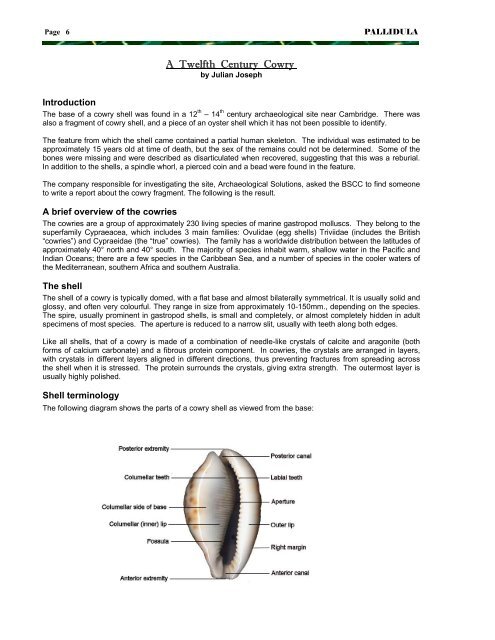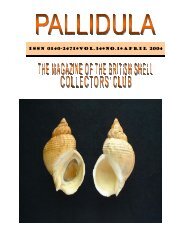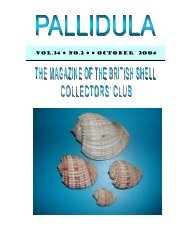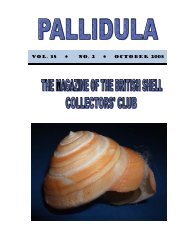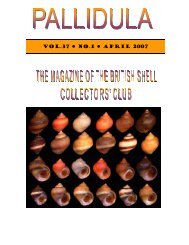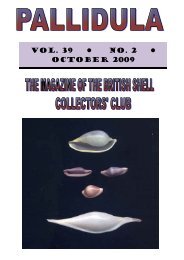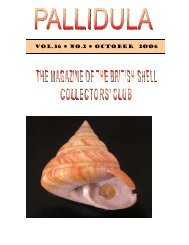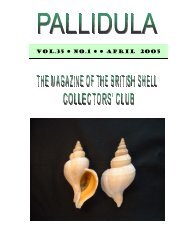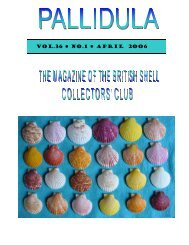VOL.35 NO.2 OCTOBER 2OO5 - British Shell Collectors' Club
VOL.35 NO.2 OCTOBER 2OO5 - British Shell Collectors' Club
VOL.35 NO.2 OCTOBER 2OO5 - British Shell Collectors' Club
Create successful ePaper yourself
Turn your PDF publications into a flip-book with our unique Google optimized e-Paper software.
Page 6 PALLIDULA<br />
A Twelfth Century Cowry<br />
by Julian Joseph<br />
Introduction<br />
The base of a cowry shell was found in a 12 th – 14 th century archaeological site near Cambridge. There was<br />
also a fragment of cowry shell, and a piece of an oyster shell which it has not been possible to identify.<br />
The feature from which the shell came contained a partial human skeleton. The individual was estimated to be<br />
approximately 15 years old at time of death, but the sex of the remains could not be determined. Some of the<br />
bones were missing and were described as disarticulated when recovered, suggesting that this was a reburial.<br />
In addition to the shells, a spindle whorl, a pierced coin and a bead were found in the feature.<br />
The company responsible for investigating the site, Archaeological Solutions, asked the BSCC to find someone<br />
to write a report about the cowry fragment. The following is the result.<br />
A brief overview of the cowries<br />
The cowries are a group of approximately 230 living species of marine gastropod molluscs. They belong to the<br />
superfamily Cypraeacea, which includes 3 main families: Ovulidae (egg shells) Triviidae (includes the <strong>British</strong><br />
“cowries”) and Cypraeidae (the “true” cowries). The family has a worldwide distribution between the latitudes of<br />
approximately 40° north and 40° south. The majority of species inhabit warm, shallow water in the Pacific and<br />
Indian Oceans; there are a few species in the Caribbean Sea, and a number of species in the cooler waters of<br />
the Mediterranean, southern Africa and southern Australia.<br />
The shell<br />
The shell of a cowry is typically domed, with a flat base and almost bilaterally symmetrical. It is usually solid and<br />
glossy, and often very colourful. They range in size from approximately 10-150mm., depending on the species.<br />
The spire, usually prominent in gastropod shells, is small and completely, or almost completely hidden in adult<br />
specimens of most species. The aperture is reduced to a narrow slit, usually with teeth along both edges.<br />
Like all shells, that of a cowry is made of a combination of needle-like crystals of calcite and aragonite (both<br />
forms of calcium carbonate) and a fibrous protein component. In cowries, the crystals are arranged in layers,<br />
with crystals in different layers aligned in different directions, thus preventing fractures from spreading across<br />
the shell when it is stressed. The protein surrounds the crystals, giving extra strength. The outermost layer is<br />
usually highly polished.<br />
<strong>Shell</strong> terminology<br />
The following diagram shows the parts of a cowry shell as viewed from the base:


